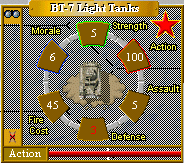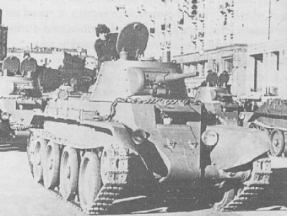
|
| Victory Points |
Armour | Start | Start | End | End | ||
| Front | Side | Rear | Month | Year | Month | Year | |
| 3 | 3 | 1 | 1 | 11 | 39 | 12 | 41 |
| BT-7 FAST TANK | ||||||||||||||||||||
| RANGE | 1 | 2 | 3 | 4 | 5 | 6 | 7 | 8 | 9 | 10 | 11 | 12 | 13 | 14 | 15 | 16 | 17 | 18 | 19 | 20 |
| HARD | 8 | 5 | 3 | . | . | . | . | . | . | . | . | . | . | . | . | . | . | . | . | . |
| SOFT | 6 | 5 | 4 | 3 | 2 | . | . | . | . | . | . | . | . | . | . | . | . | . | . | . |

|
BT-7 Fast Tank
|
Specification |
|
The BT-7 was a development of the BT-5 incorporating lessons learnt in the Khalin Gol battles against the Japanese.It retained the same automotive features but had an all-welded hull with sloping front plates to enhance protection a welded turret with sloping sides and a new track.The BT-5's limited used capability to travel on the road wheels rather then the tracks war removed. The BT-7 had several variants , including command tanks which by 1941 often had whip aerials in place of frame antennae.The OP-7 was a flame-thrower tank while the BT-7A was an artillery support variant with a short-barrelled 76.2 mm (3 in) howitzer in an enlarged turret.The final BT-8 (or BT-7M) version had a diesel engine and a machine gun to the back of the turret.Olny 706 BT-8s were produced compared to the 7,000 or so of all other BT models. BT-7s featured in the Red Army's advances into Poland in the wake of 1939 Germans invasion , and in Finland during the Winter War.But it was the German invasion of Russia in 1941 that saw the end of the BT series combat career.Shown to be under-gunned and under-armored especially against the Panzer III and Panzer IV it was phased out during 1942. |